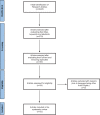Intelligent systems in obstetrics and midwifery: Applications of machine learning
- PMID: 35005483
- PMCID: PMC8686058
- DOI: 10.18332/ejm/143166
Intelligent systems in obstetrics and midwifery: Applications of machine learning
Abstract
Introduction: Machine learning is increasingly utilized over recent years in order to develop models that represent and solve problems in a variety of domains, including those of obstetrics and midwifery. The aim of this systematic review was to analyze research studies on machine learning and intelligent systems applications in midwifery and obstetrics.
Methods: A thorough literature review was performed in four electronic databases (PubMed, APA PsycINFO, SCOPUS, ScienceDirect). Only articles that discussed machine learning and intelligent systems applications in midwifery and obstetrics, were considered in this review. Selected articles were critically evaluated as for their relevance and a contextual synthesis was conducted.
Results: Thirty-two articles were included in this systematic review as they met the inclusion and methodological criteria specified in this study. The results suggest that machine learning and intelligent systems have produced successful models and systems in a broad list of midwifery and obstetrics topics, such as diagnosis, pregnancy risk assessment, fetal monitoring, bladder tumor, etc.
Conclusions: This systematic review suggests that machine learning represents a very promising area of artificial intelligence for the development of practical and highly effective applications that can support human experts, as well the investigation of a wide range of exciting opportunities for further research.
Keywords: diagnosis; intelligent systems; machine learning; midwifery; obstetrics; pregnancy.
© 2021 Barbounaki S. and Vivilaki V. G.
Conflict of interest statement
The authors have each completed and submitted an ICMJE Form for Disclosure of Potential Conflicts of Interest. The authors declare that they have no competing interests, financial or otherwise, related to the current work. V. G. Vivilaki reports that she is the Editor-in-Chief of the EJM journal.
Figures
Similar articles
-
Artificial Intelligence and Machine Learning: An Updated Systematic Review of Their Role in Obstetrics and Midwifery.Cureus. 2025 Mar 11;17(3):e80394. doi: 10.7759/cureus.80394. eCollection 2025 Mar. Cureus. 2025. PMID: 40070886 Free PMC article. Review.
-
Fuzzy Logic Intelligent Systems and Methods in Midwifery and Obstetrics.Acta Inform Med. 2021 Sep;29(3):210-215. doi: 10.5455/aim.2021.29.210-215. Acta Inform Med. 2021. PMID: 34759462 Free PMC article. Review.
-
Data-driven modeling and prediction of blood glucose dynamics: Machine learning applications in type 1 diabetes.Artif Intell Med. 2019 Jul;98:109-134. doi: 10.1016/j.artmed.2019.07.007. Epub 2019 Jul 26. Artif Intell Med. 2019. PMID: 31383477 Review.
-
A review on utilizing machine learning technology in the fields of electronic emergency triage and patient priority systems in telemedicine: Coherent taxonomy, motivations, open research challenges and recommendations for intelligent future work.Comput Methods Programs Biomed. 2021 Sep;209:106357. doi: 10.1016/j.cmpb.2021.106357. Epub 2021 Aug 16. Comput Methods Programs Biomed. 2021. PMID: 34438223 Review.
-
Using Machine Learning to Predict Complications in Pregnancy: A Systematic Review.Front Bioeng Biotechnol. 2022 Jan 19;9:780389. doi: 10.3389/fbioe.2021.780389. eCollection 2021. Front Bioeng Biotechnol. 2022. PMID: 35127665 Free PMC article. Review.
Cited by
-
Artificial Intelligence in Predicting the Mode of Delivery: A Systematic Review.Cureus. 2024 Sep 10;16(9):e69115. doi: 10.7759/cureus.69115. eCollection 2024 Sep. Cureus. 2024. PMID: 39391427 Free PMC article. Review.
-
Identification of DTL as Related Biomarker and Immune Infiltration Characteristics of Nasopharyngeal Carcinoma via Comprehensive Strategies.Int J Gen Med. 2022 Mar 2;15:2329-2345. doi: 10.2147/IJGM.S352330. eCollection 2022. Int J Gen Med. 2022. PMID: 35264872 Free PMC article.
-
The Impact of Artificial Intelligence (AI) on Midwifery Education: A Scoping Review.Healthcare (Basel). 2024 May 24;12(11):1082. doi: 10.3390/healthcare12111082. Healthcare (Basel). 2024. PMID: 38891157 Free PMC article.
-
Artificial Intelligence and Machine Learning: An Updated Systematic Review of Their Role in Obstetrics and Midwifery.Cureus. 2025 Mar 11;17(3):e80394. doi: 10.7759/cureus.80394. eCollection 2025 Mar. Cureus. 2025. PMID: 40070886 Free PMC article. Review.
References
Publication types
LinkOut - more resources
Full Text Sources
Miscellaneous

